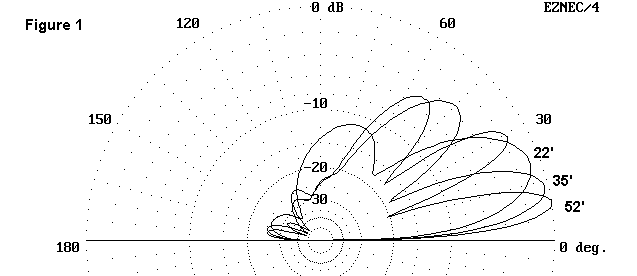 No. 5: What Difference Does Height Make?
No. 5: What Difference Does Height Make?
The general rule for antennas that we always hear is "The higher, the better." Is this true? Generally speaking, and for 10 meters, the answer is "Yes" in terms of antenna performance. (The answer may be "No" in terms of tower, rotator, antenna, and cable maintenance.) Why?
"Why" always takes more time and space to answer, but the general principle is this: the higher the antenna, the lower the take-off angle. We can get a hold of the idea of "take-off angle" by looking at Fig. 1. It shows one antenna, a three element Yagi, at heights of 22, 35, and 52 feet. These correspond to heights of 5/8 wavelength, 1 wavelength, and 1 1/2 wavelength respectively. If you extrapolate these ideas to other bands, remember that the principles apply in terms of height in wavelengths or fractions thereof.
We are interested in the lowest forward lobe to the right, the direction in which the beam is pointed. That is the main lobe, where the power is greatest (or the receiving gain is greatest). The angle of maximum radiation or gain is the take-off angle. At 22 feet, the angle for this antenna is 21 degrees; for 35 feet the angle is 14 degrees, and for 52 feet the angle is 9 degrees.

There is a second principle to consider. Most of the time, the longer the path to a distant station, the lower the angle at which the signal bounces between the antenna and the ionospheric (skip) layer. On 10 meters, many dx stations require an angle under 10 degrees, especially during marginal conditions.
The test antenna at all three heights has some power radiated under the 10 degree angle, but obviously that power increases at this angle as we raise the antenna height. When the band is wide open, that is, when skip is very strong, the differences may make no difference in the ability to make long distance contacts. The differences begin to show up under marginal conditions or in competitive situations, such as contests and dx pile-ups. Many dxers favor heights above 100 feet, especially for their 20 meter antennas (that is, about 1 1/2 wavelengths at 20, 3 wavelengths at 10).
These principles are not absolutes. Skip conditions have many variables that can alter situations. Moreover, in some applications, we may want power in the high angle lobes. State-wide 75-meter SSB coverage conveniently calls for low antennas with high skip angles, and few of us can get a 75-meter dipole very high in terms of a wavelength. On 10, the secondary lobes of the beams are useful for using shorter skip paths.
Take-off angles do not vary much among horizontal antenna types. At very low heights (about 1/2 wavelength), 3-element Yagis and quads have a couple of degrees advantage over dipoles and 2-element Yagis, but the difference in take-off angles washes out at 1 wavelength antenna heights. Hence, a dipole at 100' might outperform a 4-element Yagi at 25' for some dx paths.
Height, especially at levels below 2 wavelengths, can make some subtle differences in performance as well. The gain, front-to-back ratio, and feedpoint impedance of an antenna are not constant as we raise it. Rather, for dipoles and Yagis, gain peaks at about 5/8 wavelength and again at 1 1/4 wavelength, 10 meter heights of about 22 and 44 feet. Gain dips at 7/8 wavelength, about 30 feet up. In some antenna designs, the dip may be almost a full dB below the maximum gain at favorable heights. Of course, if you have a multiband antenna, one band's maxima may be another band's minima, so some sort of compromise is in order. These subtler differences in antenna performance also complicate antenna comparisons.
Front-to-back ratios in 2-element beams show a variable pattern of change, but director designs peak just where reflector designs dip and vice versa. Curves are smoother for 3-element Yagis. The ups and downs in gain and front-to-back ratio that parasitic beams show demonstrate the complex interactions not only directly among the elements, but also with ground reflected power that plays such an important role in real antennas. The exact phase difference between the radiated power and the ground reflected power adds or subtracts from the antenna's total in both calculable and measurable ways. How the ground reflections add or subtract varies from one kind of antenna to another.
Antennas composed of 2 elements about 1/4 wavelength apart and fed 180- degrees out of phase show a bidirectional pattern with very significant gain over a dipole. They also display an immunity to some of the effects of height, general showing a smooth curve of gain increase with height. Another feature of these antennas is that they have a strong vertical null, that is, negligible radiation straight up. Hence, the interactions of ground reflected power with the antenna are largely confined to increasing the strength of the main lobes.
These subtler interactions, of course, do not negate the first principle of
antennas. Get the thing as high as you can legally, safely, and economically maintain.
Then start operating.
Updated 3-17-97. © L. B. Cebik, W4RNL. Data may be used for personal purposes, but may not be reproduced for publication in print or any other medium without permission of the author.